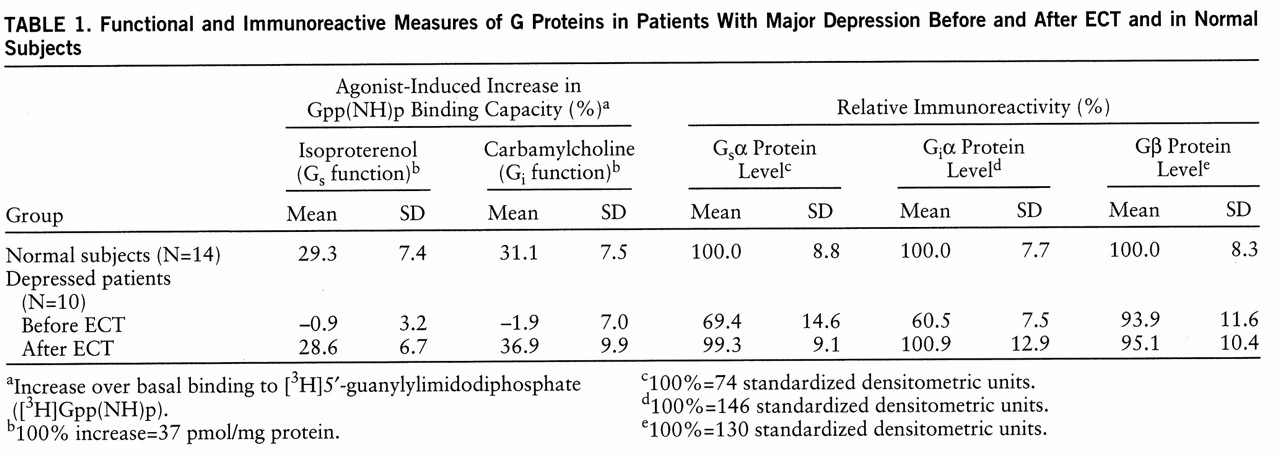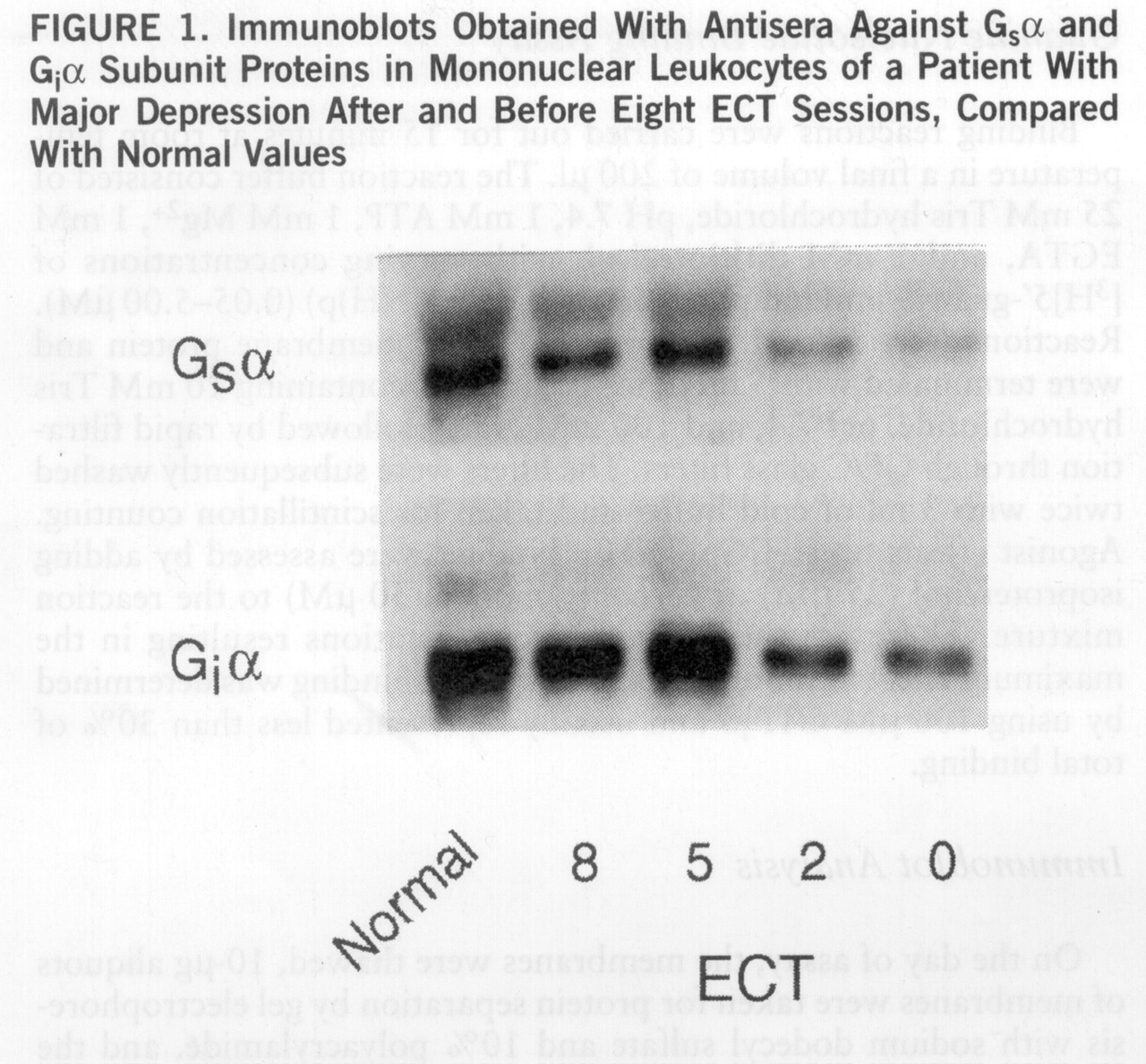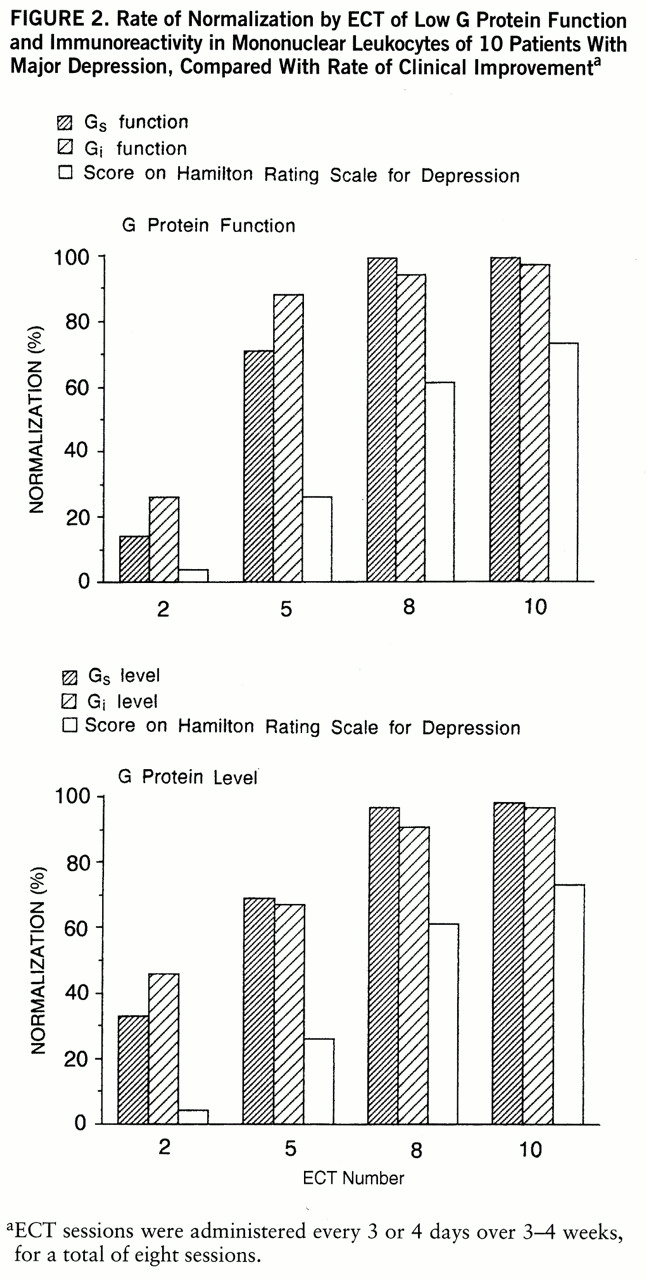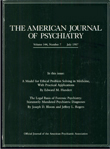Arole for monoaminergic and muscarinic cholinergic mechanisms in the pathogenesis of mood disorders has been largely suggested by and formulated in the catecholamine hypothesis and in the monoaminergic-cholinergic balance hypothesis of affective disorders (
1,
2). Biochemical research in affective disorders has focused on the cascade of events involved in signal transduction: from the level of the primary messenger (the catecholamine or acetylcholine neurotransmitter) to the level of the neurotransmitter receptors and, lately, to information transduction mechanisms beyond receptors, involving guanine-nucleotide-binding G proteins. The family of heterotrimeric G proteins are a crucial point of convergence in the transmission of signals from a variety of hormone and neurotransmitter membrane receptors to a series of downstream cellular events: intracellular second messenger effector enzymes and ionic channels (
3,
4). Evidence implicates the involvement of G proteins in the pathophysiology of mood disorders and in the biochemical mechanisms underlying the treatment of these disorders. Hyperfunctional G
s and G
i proteins were detected in mononuclear leukocytes of patients with mania (
5,
6), while hypofunctional G
s and G
i proteins were found in mononuclear leukocytes of patients with major depressive disorder (
6–
9). High immunoreactivity levels and function of G
sα were found in postmortem cerebral cortices of bipolar patients (
10–
12).
We previously found the function of receptor-coupled G
s and G
i proteins to be altered by lithium (
13–
19) and other treatments for bipolar disorder (
17–
19). The results of studies by other groups, using a variety of techniques, have generally agreed with these results and implicate involvement of G proteins in lithium's mechanism of action (
20–
26). The therapeutic spectrum of ECT, including both depression and mania, is similar to that of lithium and other drugs for bipolar illness. One way of understanding the diversity of ECT's effects on the function of a variety of neurotransmitters and receptors (for review see references 27–29) is to hypothesize that, like lithium, ECT stabilizes disregulated intracellular signaling linked to multiple transmitter systems (
27,
29). Indeed, ECT was previously shown to alter various aspects of G protein functioning in animal studies (
17–
19,
30–
32). Searching for the biochemical mechanisms of action of ECT and other treatments used against mood and other mental disorders through animal studies has intrinsic limitations. Usually, mentally disordered patients have disordered neurochemistry that is correlated with their symptomatic state. Thus, the effects of biochemical treatment on normal animals cannot be simply extrapolated to possible biochemical treatment effects in symptomatic patients with known abnormal underlying biochemistry.
Therefore, in the present study we sought to evaluate the effects of repeated electroconvulsive treatments on the low quantitative and functional measures of Gs and Gi proteins in mononuclear leukocytes of patients with major depression, addressing the following questions: 1) Do the dynamics of normalization of Gs and Gi protein function during ECT parallel the dynamics of normalization of Gsα and Giα immunoreactivity? and 2) Does normalization of the biochemical measures of Gs and Gi proteins follow, and thus reflect, clinical improvement or precede, and thus predict, clinical improvement?
METHOD
Patients
All patients were diagnosed according to DSM-IV criteria by at least two senior psychiatrists (G.S., G.R.). The inclusion criteria were normal results of physical examination, ECG, and laboratory tests for renal, hepatic, hematologic, and thyroid function. After complete description of the study to the subjects, written informed consent was obtained for repeated blood examinations. The study was approved by the institutional review board.
The 10 untreated hospitalized patients with major depression had a mean score on the Hamilton Depression Rating Scale of 26.4 (SD=5.7); there were three women and seven men, and their average age was 53.7 years (range=26–72). The healthy volunteer group consisted of 14 subjects, 10 men and four women with an average age of 50.8 years (range=25–74), from the staff of the Beer Sheva Mental Health Center and the staff's families.
ECT was administered twice a week at 3–4-day intervals by means of a MECTA-D apparatus with bitemporal electrode placement. No antidepressant medication was given to the patients during the course of ECT treatment. Anesthesia was induced by sodium pentothal (3.0 mg/kg), and the patients received succinylcholine (1.5 mg/kg), followed by oxygenation. Seizure duration was monitored centrally by the MECTA single-channel EEG monitor. A constant-current bidirectional brief-pulse square-wave stimulus was applied (pulse width, 1.5 msec; frequency, 70 Hz; duration, 1.25–2.00 seconds). In all cases blood was drawn between 8:00 and 10:00 a.m. In the course of ECT, blood was drawn at least 48 hours after the previous ECT session. The Beck Depression Inventory and the Hamilton Depression Rating Scale were administered before blood sampling.
Isolation of Mononuclear Leukocytes
Mononuclear leukocytes were isolated from 60 ml of heparinized fresh blood by using Ficoll-Paque gradient. Cells were homogenized in 25 mM Tris hydrochloride, pH 7.4, and 1 mM dithiotreitol. The homogenate was passed through two layers of cheesecloth to remove debris, and membranes were collected by further centrifugation at 18,000 g for 10 minutes. The membranes were then either freshly used for the functional binding measures or suspended in homogenization buffer containing 1 mM EGTA and 30% sucrose weight per volume and frozen at –70° until assayed by the quantitative measures. Aliquots were taken for protein concentration determination by Bradford's assay.
Guanine Nucleotide Binding Assay
Binding reactions were carried out for 15 minutes at room temperature in a final volume of 200 µl. The reaction buffer consisted of 25 mM Tris hydrochloride, pH 7.4, 1 mM ATP, 1 mM Mg2+, 1 mM EGTA, and 1 mM dithiotreitol, with varying concentrations of [3H]5′-guanylylimidodiphosphate ([3H]Gpp(NH)p) (0.05–5.00 µM). Reactions were started by adding 50 µg of membrane protein and were terminated with 5 ml of ice-cold buffer containing 10 mM Tris hydrochloride, pH 7.4, and 100 mM NaCl, followed by rapid filtration through GF/C glass filters. The filters were subsequently washed twice with 3 ml of cold buffer and taken for scintillation counting. Agonist effects on [3H]Gpp(NH)p binding were assessed by adding isoproterenol (25 µM) or carbamylcholine (50 µM) to the reaction mixture. These are the minimum concentrations resulting in the maximum effect of the agonists. Nonspecific binding was determined by using 100 µM GTPγS and usually represented less than 30% of total binding.
Immunoblot Analysis
On the day of assay, the membranes were thawed, 10-µg aliquots of membranes were taken for protein separation by gel electrophoresis with sodium dodecyl sulfate and 10% polyacrylamide, and the resulting proteins were transferred to nitrocellulose paper by use of an electroblotting apparatus. The blots were washed in Tris-buffered saline containing 3% polysorbate 20 and were blocked by incubation with 5% bovine serum albumin for 1 hour in Tris-buffered saline containing 0.1% polysorbate 20. After two washes in this solution, the blots were incubated overnight with each of the antisera (NEN-DuPont, Boston) directed specifically against Gsα (dilution 1:2,500), Gi1,2α (dilution 1:5,000), and Gβ (dilution 1:1,000) and were subsequently incubated with goat antirabbit IgG labeled with horseradish peroxidase. Immunoreactivity was detected with the Enhanced Chemiluminescence Western Blot Detection System (Amersham, Buckinghamshire, England) followed by exposure to X-ray film.
A preliminary assay of mononuclear leukocyte membranes from the healthy volunteers was carried out for determination of the range of linearity of the assay with respect to protein concentration. Linearity was found between 2.5 and 15.0 µg of membrane protein. Quantitation of the immunoblots was performed by densitometric scanning by means of an image analysis system. An aliquot of pooled standard membranes from rat brain cortex was run on one lane of every gel, and the immunolabeling was calculated in relation to this standard. This normalization procedure was carried out to minimize the between-blot variability. Although anti-Gsα detects both the 52- and 45-kDa Gsα species, only the 45-kDa species is consistently clearly detected in leukocytes, while rat cortex membranes show predominantly the 52-kDa species. The other subunits assayed in leukocytes were found to migrate at the expected molecular weights, similarly to those labeled in the rat cortex membranes.
Statistical Analysis
Correlations of the functional and quantitative measures of G proteins in the mononuclear leukocytes of the depressed patients before ECT to those evaluated during the course of ECT were conducted by using the Spearman rank correlation. Differences in the agonist-induced increases in Gpp(NH)p binding capacity and the immunoreactivities of the various G protein subunits between the depressed patients before the initiation of ECT and the healthy volunteer group and between the depressed patients after completion of treatment and the healthy volunteers were determined through Bonferroni-corrected t tests for multiple comparisons of three groups by dividing alpha by 3. The results before and after ECT within the patient group were compared through paired t tests.
RESULTS
The G protein function in mononuclear leukocyte membranes was measured through increases in [
3H]~Gpp(NH)p binding capacity induced by the β-adrenergic agonist isoproterenol or the muscarinic agonist carbamylcholine. Both agonists induced significant increases in Gpp(NH)p binding capacity without substantially affecting the affinity of binding. Isoproterenol-enhanced Gpp(NH)p binding capacity was specifically blockable by the β-adrenergic antagonist propranolol and by pretreatment with cholera toxin, with no effect of pertussis toxin, indicating a specific effect through G
s protein. Carbamylcholine effects on guanine nucleotide binding were specifically blockable by the M
2 selective antagonist ADFX-116 and were exerted in a specific pertussis-toxin-sensitive manner, suggesting coupling with G
i protein (
33).
As shown by Bonferroni t tests, in comparison with the age- and sex-matched healthy subjects, the patients with depression, while untreated, had statistically significant lower function of mononuclear leukocyte G
s (t=13.58, df=22, p<0.001) and G
i (t=11.05, df=22, p<0.001) proteins and significantly lower mononuclear leukocyte immunoreactivity of the G
sα (t=5.91, df=22, p<0.001) and G
iα (t=12.50, df=22, p<0.001) subunit proteins. The immunoreactive levels of the Gβ subunit protein in the mononuclear leukocytes of the depressed patients and the healthy subjects were similar (
table 1).
The low G
s and G
i protein function (measured through isoproterenol- and carbamylcholine-enhanced Gpp(NH)p binding capacity) and immunoreactive measures in the mononuclear leukocytes of the untreated patients with depression were found to be normalized by ECT in a statistically significant manner, according to paired t tests (G
s function: t=11.20, df=9, p<0.001; G
i function: t=12.23, df=9, p<0.001; G
sα immunoreactivity: t=4.43, df=9, p<0.002; G
iα immunoreactivity: t=4.86, df=9, p<0.001). The G protein measures after ECT were found to be not significantly different from those characterizing the group of healthy subjects, according to Bonferroni t tests (G
s function: t=0.24, df=22, n.s.; G
i function: t=1.56, df=22, n.s.; G
sα immunoreactivity: t=0.18, df=22, n.s.; G
iα immunoreactivity: t=0.20, df=22, n.s.) (
table 1).
Repeated measurements of G
s and G
i protein function and of the immunoreactivity of the G
sα and G
iα subunit proteins were conducted during the course of ECT in parallel with repeated clinical evaluations of depressive symptoms.
Figure 1 is a representative example of immunoblots obtained for the quantitation of G
sα and G
iα proteins from mononuclear leukocytes of a patient with major depression undergoing ECT. The figure depicts normalization of the low G
sα and G
iα immunoreactivity in the course of ECT. The detailed dynamics of normalization of the measures of G protein function (
figure 2, top) and immunoreactivity (
figure 2, bottom) in the mononuclear leukocytes of the depressed patients during the course of ECT in relation to the dynamics of clinical improvement reveal that the biological normalization preceded clinical improvement by at least a week.
There were significant positive correlations between the biochemical functional measures of G proteins, namely isoproterenol- and carbamylcholine-enhanced Gpp(NH)p binding capacity, and the respective immunoreactive measures of Gsα and Giα in the mononuclear leukocytes of the depressed patients undergoing ECT (Gsα: rs=0.76, N=38, p<0.001; Giα: rs=0.74, N=39, p<0.001). It can therefore be concluded that the dynamics of normalization of Gs and Gi protein function during ECT parallel the dynamics of normalization of Gsα and Giα immunoreactivity.
DISCUSSION
Our results show that the dynamics of normalization by ECT of the low function of Gs and Gi proteins parallels the dynamics of normalization of the low immunoreactivity of Gsα and Giα subunit proteins. The correlation between the function of Gs and Gi and their immunoreactive measures in mononuclear leukocytes of depressed patients at various stages of ECT supports a direct alteration at the G protein level. It can be concluded that the normalization of the low Gs and Gi function by ECT is related to a normalization of the low quantities of these proteins as shown by Gsα and Giα immunoreactivity.
The mechanisms underlying the alterations in G protein levels and function in mononuclear leukocytes of depressed patients and their normalization by ECT are still unknown. Increasing evidence indicates the existence of neurally mediated immunomodulatory mechanisms (
34), involving the hypothalamic-pituitary axis and the sympathetic and parasympathetic innervation of primary and secondary lymphoid organs (
35). Thus, alterations in mononuclear leukocyte G proteins may reflect 1) primary systemic alterations in G proteins similar to possible biochemical alterations in CNS signal transduction induced by the depressive episode and/or by ECT; 2) secondary influences of circulatory primary messengers, altered by the depressive state and/or by ECT; 3) secondary influences of altered sympathetic and parasympathetic innervation of lymphoid organs induced by the depressive state and/or by ECT. Most of the circulating lymphocytes are T cells whose lifespan is long: months or years (
36). The lifespan of B cells is generally shorter: days or weeks (
36). Both types of cells may have shorter transit times in the blood and tend to migrate to lymphoid organs. The majority of the long-living cells belong to a recirculating pool (
36). Since repeated measurements of mononuclear leukocyte G proteins during a time period of around 3 weeks were conducted in the present study, it should be noted that the population of peripheral mononuclear leukocytes might be turning over or turning around through lymphoid organs throughout the course of ECT. Thus, the effects of depression and of ECT are probably exerted on the G proteins of cells in bone marrow and other lymphoid organs in addition to those in mononuclear leukocytes circulating in blood.
The differences in G protein measures between the depressed patients and the healthy subjects were not merely due to motor hyper- or hypoactivity, as normal subjects after intensive physical exercise (
37) show G protein measures no different from the values for our healthy volunteer subjects. Also, G protein measures in the mononuclear leukocytes of elderly volunteer subjects, who in general are less physically active, did not differ from the measures in active, young subjects (
38).
We are aware that the involvement of G proteins in the pathophysiology of depression and/or ECT, as implicated by the data presented here, should be considered cautiously, since extrapolations from findings obtained in blood cells peripheral to the CNS are not straightforward. We have discussed this issue in detail in a previous paper (
8).
Our previous findings of high G
s and G
i protein function and G
sα and G
iα immunoreactivity levels in mononuclear leukocytes of manic patients (
5,
6) and of low G
s and G
i protein function and low G
sα and G
iα immunoreactivity levels in unipolar and bipolar depressed patients (
6–
8) suggest that G
s and G
i protein quantitative and functional measures in mononuclear leukocytes are biochemical indicators of the affective state, rather than trait markers of bipolar mood disorder. Moreover, the function and quantity of both G
s and G
i were found to be significantly correlated with the severity of depressive symptoms (
7,
8). The functional measurements of β-adrenergic-receptor-coupled G
s protein conducted in the present and previous studies are in accord with other functional findings of low β-adrenergic-coupled adenylate cyclase activity in patients with depression (
39–
43). In accord with the findings suggesting that the abnormalities in G protein measures in mononuclear leukocytes of mood-disordered patients should be considered state rather than trait markers, it should be noted that no structural or regulatory abnormalities in the gene for the G protein stimulatory α subunit were found in patients with bipolar disorder (
44). Previous results have shown that the abnormalities in G protein functional measures are normalized by specific treatments: lithium-treated eu~thymic bipolar patients (
5,
37) and antidepressant-treated mood-disordered patients (
37) showed G protein function similar to that of control subjects, and those findings support the notion that alterations in G protein function in mononuclear leukocytes of affective disorder patients reflect their mood state. In this regard, the present findings showing low function and immunoreactivity of G
s and G
i proteins in unipolar depressed patients, and normalization of the function and immunoreactive levels of G
s and G
i proteins in the course of ECT, support the notion that mononuclear leukocyte G protein measures in mood disorders are state rather than trait markers.
The normalization by ECT of the biochemical measures of Gs and Gi function and of Gsα and Giα immunoreactivity levels did not follow, and thus reflect, the clinical improvement of the depressed patients. Rather, they preceded clinical improvement by at least a week. Gs and Gi protein functional and quantitative measurements in mononuclear leukocytes of patients with depression may thus potentially serve not only as a biochemical marker for the affective state of these patients but also as a biochemical means of predicting and evaluating response to ECT. It would be interesting to explore in the future whether psychotherapeutic intervention in depression can induce normalization of low G protein measures and, if so, whether the normalization of the biochemical measures precedes, as in the present study, or follows clinical improvement.




